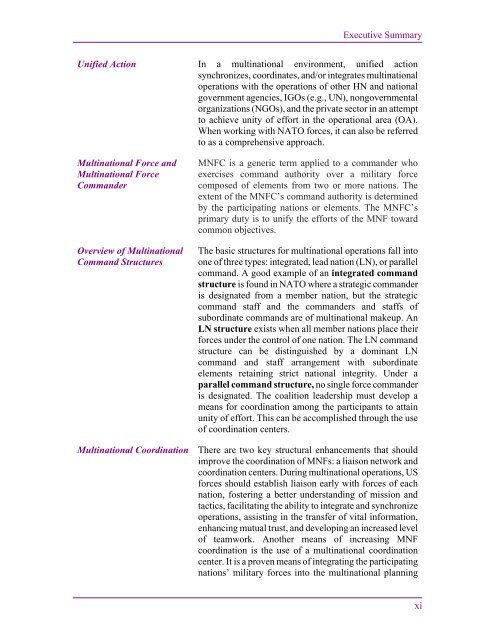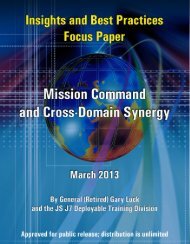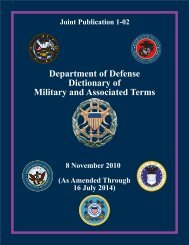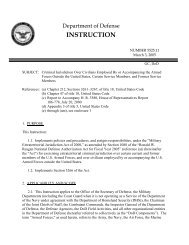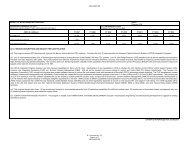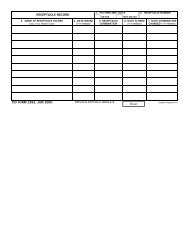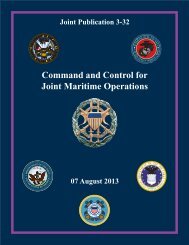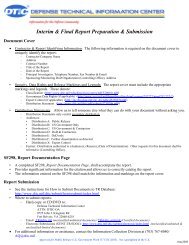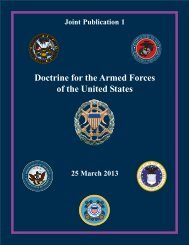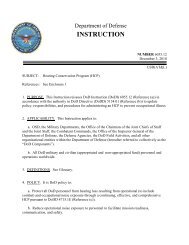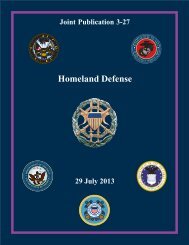JP 3-16, Multinational Operations - Defense Technical Information ...
JP 3-16, Multinational Operations - Defense Technical Information ...
JP 3-16, Multinational Operations - Defense Technical Information ...
You also want an ePaper? Increase the reach of your titles
YUMPU automatically turns print PDFs into web optimized ePapers that Google loves.
Executive Summary<br />
Unified Action In a multinational environment, unified action<br />
synchronizes, coordinates, and/or integrates multinational<br />
operations with the operations of other HN and national<br />
government agencies, IGOs (e.g., UN), nongovernmental<br />
organizations (NGOs), and the private sector in an attempt<br />
to achieve unity of effort in the operational area (OA).<br />
When working with NATO forces, it can also be referred<br />
to as a comprehensive approach.<br />
<strong>Multinational</strong> Force and<br />
<strong>Multinational</strong> Force<br />
Commander<br />
Overview of <strong>Multinational</strong><br />
Command Structures<br />
MNFC is a generic term applied to a commander who<br />
exercises command authority over a military force<br />
composed of elements from two or more nations. The<br />
extent of the MNFC’s command authority is determined<br />
by the participating nations or elements. The MNFC’s<br />
primary duty is to unify the efforts of the MNF toward<br />
common objectives.<br />
The basic structures for multinational operations fall into<br />
one of three types: integrated, lead nation (LN), or parallel<br />
command. A good example of an integrated command<br />
structure is found in NATO where a strategic commander<br />
is designated from a member nation, but the strategic<br />
command staff and the commanders and staffs of<br />
subordinate commands are of multinational makeup. An<br />
LN structure exists when all member nations place their<br />
forces under the control of one nation. The LN command<br />
structure can be distinguished by a dominant LN<br />
command and staff arrangement with subordinate<br />
elements retaining strict national integrity. Under a<br />
parallel command structure, no single force commander<br />
is designated. The coalition leadership must develop a<br />
means for coordination among the participants to attain<br />
unity of effort. This can be accomplished through the use<br />
of coordination centers.<br />
<strong>Multinational</strong> Coordination There are two key structural enhancements that should<br />
improve the coordination of MNFs: a liaison network and<br />
coordination centers. During multinational operations, US<br />
forces should establish liaison early with forces of each<br />
nation, fostering a better understanding of mission and<br />
tactics, facilitating the ability to integrate and synchronize<br />
operations, assisting in the transfer of vital information,<br />
enhancing mutual trust, and developing an increased level<br />
of teamwork. Another means of increasing MNF<br />
coordination is the use of a multinational coordination<br />
center. It is a proven means of integrating the participating<br />
nations’ military forces into the multinational planning<br />
xi


